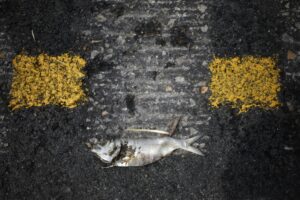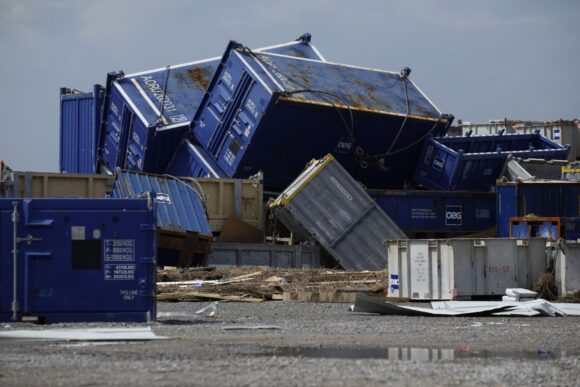Exxon Mobil Corp. released sulfur dioxide and hydrogen sulfide at its Baton Rouge refinery as Hurricane Ida churned ashore. A broken pipeline poured crude oil near a bayou that flows into the Gulf of Mexico. And a miles-long black slick has appeared near an offshore rig off the state’s coast, stirring fears of a spill.
Days after the storm swept through the region, the environmental aftermath is emerging in a petrochemical corridor packed with hazardous-chemical plants and refineries.
In some areas, the chemicals are mixing with raw sewage released from treatment plants that lost power.
“We are totally not prepared for these types of events,” said Wilma Subra, an environmental scientist with the Louisiana Environmental Action Network in Baton Rouge. “We should be, however we are not.”

Nearly 100 spills and other episodes have been reported to the Louisiana Department of Environmental Quality as of Thursday afternoon, raising concerns among environmentalists and public health officials about toxic discharges.
Among the chemicals released was anhydrous ammonia from two storage tanks at a CF Industries fertilizer facility near the Mississippi River in Donaldsonville, Louisiana, according to the state agency. A CF Industries spokesman said the issue was resolved and that there had been no off-site impacts.
Exxon said in a statement that the release from its Baton Rouge facility “was quickly isolated and contained to the unit” and that chemical readings are now below detection limits.
A Koch Industries Inc. subsidiary, Koch Nitrogen, reported a release of the highly toxic, colorless gas at a site near the Mississippi. The company didn’t respond to a request for comment.
Phillips 66 reported that two separate pipelines were leaking hazardous propylene and isobutane in St. Charles Parish. A company spokesman said there was no anticipated impact to soil and water and that the propylene was being “safely flared.” The company said though it had made a preliminary report of a release of isobutane, “initial reconnaissance” showed no visible signs of release and that it continued to investigate.
And the U.S. Environmental Protection Agency said it had been in touch with Royal Dutch Shell Plc about its Norco refinery because of “excessive smoke seen in the community.”
Raw sewage has also been released. A “complete power failure caused 95% of lift stations to fail” in New Orleans’ Jefferson Parish sewer system, resulting in a release of hundreds of thousands of gallons of wastewater, according to the Louisiana DEQ.
“Our entire sewage system operates on electricity,” said Mike Lockwood, director of the Jefferson Parish Department of Sewage.
Unknown amounts of raw sewage is also being discharged into the Mississippi River near 14 water intakes used by 11 drinking water facilities, the EPA said, citing a notification from the New Orleans Water and Sewerage Board, which said the release was due to a generator failure. And in neighboring Alabama, that state’s Department of Environmental Management reported flooding from the storm caused tens of thousands of gallons of untreated sewage to be released in the state.
“Sewage overflows are a serious threat to public health and our ecosystems,” said John Rumpler, a senior director with the group Environment America, “Pathogens in our waterways make millions of people sick every year.”
The Louisiana Department of Environmental Quality also received several reports of oil-like sheens in the water, including one “from an unknown source” in the lower Mississippi River. Greg Langley, an agency spokesman, said it would be assisting the Louisiana Oil Spill Coordinator’s Office to investigate reports of a miles long slick near an offshore rig in the gulf. The U.S. Bureau of Safety and Environmental Enforcement said it was investigating.
The state also had reports of crude oil leaking from damaged tanks, leaking well heads, flooded facilities, as well one that was creating a “dark stream of oil” in the Gulf of Mexico, and another sheen from a well in East Timbalier National Wildlife Refuge, a protected island in southern Lafourche Parish.
“It looks like there is widespread pollution,” said Naomi Yoder, a staff scientist at Healthy Gulf, a nonprofit environmental group.
As the remnants of the storm traveled north, unleashed a torrent of water in the northeast, the EPA reported “significant and wide-spread flooding” at the toxic American Cyanamid Superfund site in Bridgewater Township, New Jersey. The site, which is contaminated with volatile organic compounds, metals, and chemicals, is located next to the Raritan River above the Brunswick Aquifer — New Jersey’s second largest source for drinking water, according to the EPA.
Flooding and other damage from Ida, carried on some of the most powerful winds ever to hit Louisiana, caused widespread power failures that have hindered officials’ ability to access the damage. The Louisiana DEQ said it was being hampered by communications problems and that a number of its air quality monitoring stations had been knocked offline.
“Everyone is strained to their breaking point right now,” said Patrick Courreges, a spokesman for the Louisiana Department of Natural Resources.
–With assistance from Elizabeth Elkin and Josyana Joshua.
About the photo: Offshore oil supply containers are strewn about after Hurricane Ida’s storm surge swept through Port Fourchon, Louisiana.
Was this article valuable?
Here are more articles you may enjoy.


 California Governor Seeks $200M to Replace EV Tax Credits Cut by Trump
California Governor Seeks $200M to Replace EV Tax Credits Cut by Trump  Billionaire NFL Owner Suing Over Billboards Near His SoFi Stadium
Billionaire NFL Owner Suing Over Billboards Near His SoFi Stadium  Palantir Poaching Suit Called ‘Scare’ Tactic by Ex-Employees
Palantir Poaching Suit Called ‘Scare’ Tactic by Ex-Employees  Cyber Breach Affected 750,000 Canadian Investors, Regulator Says
Cyber Breach Affected 750,000 Canadian Investors, Regulator Says 